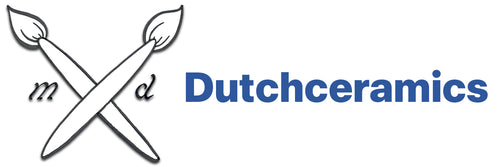Where to buy pottery cookie for ceramics?

If you search for “cookie” on the Internet, you'll mostly find cookies and pastries. But in the ceramic world, this word has a very different meaning. Ceramic cookie (in English 'bisqueware') is clay that has been fired once. This gives it an open, porous structure that is perfect for painting or glazing. Why? Because the bisqueware easily absorbs the paint or glaze. This decoration step is then usually followed by the second firing, called the glaze firing.
The glazing process
During the glaze firing, the painted cookie is baked at a higher temperature. Here, the glaze melts and forms a smooth, hygienic layer over the ceramic. The beauty of transparent glaze is that the previously applied decoration remains clearly visible, with our fine white-firing clay as a background. We call this “underglaze paint” because the decoration is encapsulated, as it were, behind a layer of “glass. There are also techniques to decorate on top of the glaze, for example with glaze paint or in-fire transfers. Check out the production process here!
Different types of cookie
Like pottery, stoneware and porcelain, cookie has different firing temperatures. For example, our pottery receives an initial cookie firing of 1000-1020 degrees. This makes it sufficiently hard, but keeps it paintable. You can also dip it in a bucket of glaze just fine if you don't use a brush or spray gun. By the way, we use Sibelco WB30 clay, the standard for flatware and decorative pottery. This clay is suitable for glaze firing to over 1150 degrees, which makes it perfect for intensive domestic use.
Where do you find cookie?
Here's a challenge. There is a big gap between individual potters (hand turners or those working with plaster molds) and the remaining Dutch pottery manufacturers. Not every hobbyist has the space or budget for plaster molds, a clay ton with drive gear and a compressor. Cookie is actually a semi-finished product from the (craft) small industry, and often only available from importers or hobby stores.
Having your own Delft Blue sign made
Fortunately, there is a solution. Montagne Dutchceramics (founded in 1951), with its roots in the heyday of Gouda plateel, has built up a huge collection of shapes and items. With acquisitions from well-known Gouda plate factories such as Jumbo, deWit and Plateelbakkerij Schoonhoven (founded 1920), the ongoing collection includes more than 1,000 different models: dinnerware, vases, animals, figures, tiles, urns, wall sconces, houses and pitchers.
The entire collection (except commissioned forms) can be viewed and purchased by appointment. There is deliberately no catalog or webshop for this semi-finished product - that would make everything unnecessarily expensive. When you visit the factory in Gouderak, you can view everything, see the prices and put together your own collection directly. You can also order special occasion signs by simply sending an email with your desired drawing before placing your order.
More information? Email info@dutchceramics.com or call 0182 373839.

